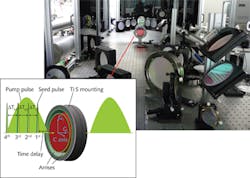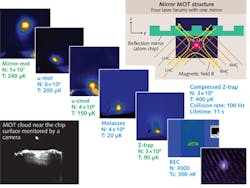Laser Science in China: A rich history of photonics research continues to bear fruit at SIOM
RUXIN LI
Founded in May 1964, the Shanghai Institute of Optics and Fine Mechanics (SIOM) has been widely recognized as the most important research center of laser science and technology in China. SIOM is one of approximately 100 institutes of the Chinese Academy of Sciences (CAS), and its origin lies with the laser research groups of the CAS institutes in Beijing and Changchun, where the first Chinese ruby laser oscillator was demonstrated in 1961.
SIOM has become a comprehensive research institute with primary research fields that include high-power laser technologies, high-field laser physics, information optics, quantum optics, solid-state laser technologies and their applications, and materials for laser and optoelectronics. Here, in commemoration of our 50th anniversary, I would like to highlight some recent progress on laser technology development and physics research.
Fusion research
SIOM has focused on the research and development of high-power laser technology and engineering for decades. In addition to the earlier achievements in the development of high-power laser technologies and facilities for laser fusion experiments, SIOM has developed in recent years the first Chinese multikilojoule laser facility, Shenguang (SG for short and means "magic light" in Mandarin)-II facility. The SG-II laser facility includes eight laser beams (Fig. 1) in two bundles and a multifunctional beam (the ninth beam). The time synchronization among laser beams is within 10 ps root-mean-square (RMS).
In this facility, a fiber oscillator, fiber amplifier, and high-performance integrated waveguide element have been used in the seed units. The timing jitter (10 ps level) between different pulses is controlled efficiently by a unique short optical pulse trigger technology. A single-pixel spatial light modulator has been developed to actively control the near-field intensity of laser beams, and therefore an arbitrary spatial distribution can be easily obtained. Furthermore, an active wavefront control system is designed, optimized, and integrated in the ninth beam. The main components include a deformable mirror and a Hartmann wavefront sensor for each of the nine beams. A computer controller is adopted to correct laser aberrations, and then a good focusing ability can be obtained.
The SG-II laser facility has been stably operated for more than10 years and will be upgraded to a 20 kJ class laser facility in the near future. This facility has become an international user facility for high-energy density physics research. One of the most exciting experiments recently conducted in the facility involves laboratory astrophysics, such as the modeling of loop-top X-ray source and reconnection outflows in solar flares.1
Ultra-intense fs lasers
SIOM developed the first Chinese petawatt (PW) femtosecond laser facility in 2007 using a chirped pulse amplification (CPA) scheme. This laser system was recently upgraded to 2 PW based on a 100-mm dia. Ti:sapphire amplifier (see Fig. 2),2 which to our knowledge is the highest peak power ever achieved with a laser system. With a newly developed high-contrast broadband front end, the signal-to-noise ratio of the 26 fs long laser pulse was also improved.The suppression of transverse parasitic lasing is regarded as a serious technical bottleneck for larger aperture CPA amplifiers of 10 PW class. As an alternative, optical parametric chirped-pulse amplification (OPCPA) can support higher energy amplification without producing a photoluminescence effect. Lithium triborate (LBO) is an attractive nonlinear crystal that can support high-efficiency and broadband OPCPA near 800 nm wavelength. A 10 PW or higher peak power femtosecond laser system can be developed by combining the Ti:sapphire-based CPA chain and a LBO-based OPCPA booster amplifier. SIOM recently implemented a hybrid Ti:sapphire-CPA and LBO-OPCPA laser system,3 which can produce an amplified pulse energy of 28.68 J with a spectral bandwidth of 80 nm (FWHM). After pulse compression, the peak power of the laser system is 0.61 PW, and the pulse length is 33.8 fs.
High-field laser physics
The laser wakefield accelerator (LWFA) can now produce multi-GeV electron beams on a much smaller scale than the conventional radiofrequency accelerators. Based on the tunnel-ionization-induced injection in the first stage, an all-optical cascaded LWFA with near-GeV quasi-monoenergetic electron beams (QMEBs) was first realized at SIOM.4 The collimated QMEBs with peak energy of ~0.8 GeV are achieved with an acceleration gradient of 187 GV/m.
A key issue in the staged LWFA scheme is controlling the seeding phase of electrons into the second stage, which SIOM recently demonstrated for the two-stage LWFA. By optimizing the seeding phase of electrons into the second stage, electron beams beyond 0.5 GeV with 3% RMS energy spread were produced over a short acceleration distance of 2 mm. Peak energy of the electron beam was further extended beyond 1 GeV by lengthening the second acceleration stage to 5 mm.5
Filamentation of intense femtosecond laser pulses in air is an important topic in high-field physics. A spectacular snowfall was induced by the filamentation of high-repetition-rate femtosecond laser pulses in a cloud chamber for the first time.6 Furthermore, SIOM demonstrated waveform-controlled terahertz radiation from an air-filament plasma driven by phase-stabilized few-cycle laser pulses.7
In recent studies, remote air lasing was created due to instantaneous buildup of population inversion in air molecular ions.8,9 Of special note, it was also demonstrated that alignment-dependent ionization probabilities of molecules from lower-lying orbitals can be retrieved by detecting the alignment dependence of fluorescence emission from tunnel-ionized carbon dioxide molecules.10
Advanced solid-state lasers
SIOM has been developing space-borne solid-state lasers and lidar systems since 2001. To date, several lasers were implemented in lidar systems that are now in orbit. The first space-qualified solid-state laser was the transmitter of the laser altimeter on China's lunar explorer Chang'E-1. This diode-pumped NdCr:YAG laser with pulse energy of 150 mJ at 1064 nm and pulse width of 5 ns was launched in 2007 and operated at 1 Hz repetition rate for ~16 months in orbit.
Every aircraft in China's lunar program since then has been equipped with space-qualified solid-state lasers manufactured by SIOM. On the Chang'E-3 probe, a Yb-doped pulsed fiber laser system with 7 ns pulse width and 50 kHz repetition rate was developed as the transmitter of the scanning image lidar. To our knowledge, it was the first space-qualified fiber laser operating in deep space.
In addition to the lasers for the Chang'E Program, different types of space-qualified lasers with long life and high reliability have also been developed in SIOM, including mid-energy diode-pumped solid-state lasers, single-frequency lasers, and mid-average-power pulsed fiber lasers.
SIOM was also one of the earliest research institutes engaged in developing high-power fiber lasers in China. In 2002, a 3.9 W single-mode fiber laser was demonstrated. Using our own double-clad fiber, up to 1.75 kW CW was obtained in 2009. In 2013, SIOM successfully assembled a 1.5 kW all-fiber engineering prototype with a beam quality m2 of 1.46. Significant progress has also been achieved in high-peak-power pulsed fiber lasers. Coherent-beam-combining (CBC) technology was also demonstrated in 2008 with two-dimensional four-fiber-laser CBC output by using a self-imaging cavity. With the realization of pulse-superposition and phase-locking, we have obtained excellent CBC for a multichannel fiber amplifier array with approximately 88.7% visibility of the far-field interference pattern.
Cold-atom physics
In recent years, SIOM's research into cold-atom physics has mainly focused on the application of laser cooling techniques, including Bose-Einstein condensates (BECs), atom chips, atom guiding with a radio-frequency field, atom interferometers, and strong coupling plasma physics in cold-atom systems. A rubidium (Rb) BEC was demonstrated in 2002 and a Rb BEC on an atom chip in 2008 (see Fig. 3).Recently, we investigated the interactions between heteronuclear atoms, such as Rb and Yb, and demonstrated an atomic gyroscope on an atomic chip.
Research on time and frequency standards includes new conceptual microwave clocks, time and frequency transfer and dissemination in optical fibers, and optical frequency standards. The first Rb fountain clock was built in 2005; its stability now reaches to 2 ×10-15.
SIOM is also developing a space cold-atom clock that will be used in the Chinese Space Station to pursue the performance limit of microwave clocks. Besides the primary clock, the scientists developed two types of compact clocks with high stability to the level of ~10-15, including an integrating-sphere cold-atom clock and a pulsed optically pumped clock in a vapor cell.
Research on frequency transfer mainly focuses on control of noise in optical fiber for remote users. To meet the requirements of next-generation applications on frequency standards, SIOM is developing optical frequency standard techniques, including a mercury optical-lattice clock, an ultrastable laser via fiber interference, and optical frequency transfer and dissemination in a dark fiber.
High-power laser materials
Together with Hoya and Schott, SIOM is one of three global suppliers of large (up to 400 mm clear aperture) Nd-doped laser glass slabs, which are the key active material of high-power laser-fusion drivers. SIOM can provide commercial Nd:glass slabs up to 810 × 460 mm in size with a good wavefront performance (figure error less than 1/3 wavelength).
As for high-power long-lifetime flashlamps, more than 30 patented technologies have been granted to SIOM. Both pulsed and continuous flashlamps are available in different sizes and shapes, including linear, helical, and U-shaped. Dimensions range from 5 to 185 cm in arc length and from 3 to 42 mm in bore diameter.
Moreover, optical coatings for high-power laser applications can be customized for wavelength ranges from deep ultraviolet to infrared. The laser-induced damage thresholds for mirrors and polarizers are greater than 60 J/cm2 and 30 J/cm2 (1064 nm, 10 ns) respectively, which are the leading levels among the "thin film damage competition" results from the SPIE Laser Damage symposiums in recent years.
References
1. J. Zhong et al., NaturePhys., 6, 984 (2010).
2. Y. X.Chu et al., Opt. Express, 21, 29231 (2013).
3. J.-Y. Lee et al., Opt. Lett., 38, 4837 (2013).
4. J. S. Liu et al., Phys. Rev. Lett., 107, 035001 (2011).
5. W. T. Wang, et al., Appl. Phys. Lett. 103, 243501 (2013).
6. J. J. Ju et al., Opt. Lett., 37, 1214 (2012).
7. Y. Bai et al., Phys. Rev. Lett., 108, 255004 (2012).
8. J. P. Yao et al., Phys. Rev. A, 84, 051802(R) (2011).
9. H. Zhang et al., Phys. Rev. X3, 041009 (2013).
10. J. Yao et al., Phys. Rev. Lett., 111, 133001 (2013).
Ruxin Li is director, Shanghai Institute of Optics and Fine Mechanics, Chinese Academy of Sciences; e-mail: [email protected]; http://english.siom.cas.cn.


